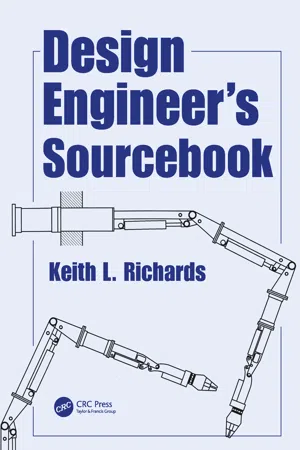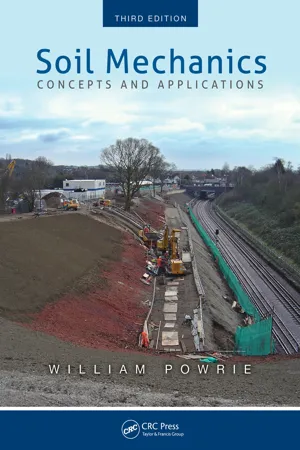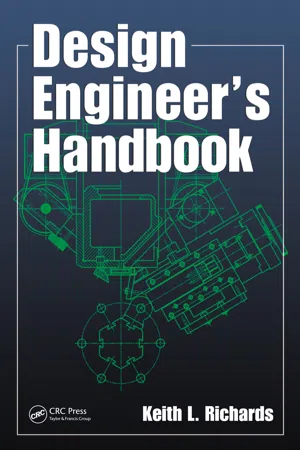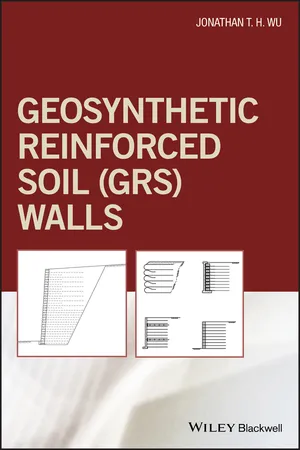Technology & Engineering
Mohr's Circle for Strain
Mohr's Circle for Strain is a graphical method used to analyze the state of strain at a point in a material. It represents the normal and shear strains on two perpendicular planes and provides a visual representation of the principal strains and their orientations. By using Mohr's Circle, engineers can determine the maximum and minimum strains and the orientation of the planes on which they occur.
Written by Perlego with AI-assistance
Related key terms
1 of 5
9 Key excerpts on "Mohr's Circle for Strain"
- eBook - ePub
- K. L. Richards(Author)
- 2017(Publication Date)
- CRC Press(Publisher)
14Introduction to Analytical Stress Analysis and the Use of Mohr’s Circle
14.1 Introduction
Of all the graphical methods used by an engineer for visualizing problems, there is little doubt that Mohr’s circle is the best known; in its various applications it is an aid to visualizing a stress or strain problem.The object of this chapter is to explore with a reasonable thoroughness three important uses of Morh’s circle. These applications confront the engineer and designer in many branches of mechanical and structural engineering.In the development of the circle construction, it has been considered desirable to present a concise account of the underlying theory. It is possible for the reader more interested in applications to accept these results and go straight to those sections dealing with the constructions and applications.Nearly all textbooks, of necessity, deal with the circle in too cursory a manner and leave many detailed questions unanswered. It is hoped that this chapter devoted solely to the circle will answer more of these questions. In illustrating the text with examples of a practical nature, other topics of strength of materials will be quoted, the background of which can be found in the most strength of materials textbooks. - eBook - PDF
Soil Mechanics
Concepts and Applications, Third Edition
- William Powrie(Author)
- 2018(Publication Date)
- CRC Press(Publisher)
(The angle, measured at the centre of the Mohr circle, between diameters representing different planes is twice the physi-cal angle between those planes in reality). 2.2.6 Mohr circle of strain Strain, like stress, may be classified as either direct or shear (Figure 2.5). Direct strain is given the symbol ε . Engineering shear strain, defined in Figure 2.5b, is given the symbol γ . Mohr circle of effective stress Centre at s uni2032= ( uni03C3uni2032 1 + uni03C3uni2032 3 ) Radius t = ( uni03C3uni2032 1 – uni03C3uni2032 3 ) t t u (a) (b) O Radius t = ( uni03C3 1 – uni03C3 3 ) 1 2 1 2 Mohr circle of total stress Centre at s = ( uni03C3 1 + uni03C3 3 ) 1 2 1 2 uni03C4 O uni03C4 uni03C3uni2032 3 uni03C3uni2032 3 uni03C3uni2032 1 uni03C3uni2032 uni03C3 1 uni03C3uni2032 3 uni03C3, uni03C3uni2032 uni03C3 3 s uni2032 s uni2032= s ( uni03C3uni2032, uni03C4 ) 1 2 ( uni03C3uni2032 1 + uni03C3uni2032 3 ) 2 uni03B8 Figure 2.4 Mohr circles of stress showing (a) the circles representing total and effective stress separated by the pore water pressure, u; and (b) the stress state on an imaginary 'cut' at an angle θ anticlock-wise from the plane on which the major principal effective stress acts. Soil strength 65 © 2010 Taylor & Francis Group, LLC The engineering shear strain, γ , is the overall decrease in the angle between the positive directions of two perpendicular lines—in the case of Figure 2.5, the x and y axes.) The same systems of subscripts are used as for stresses. If a material is elastic, the directions of the principal strain increments will coincide with the directions of the principal stress incre-ments during an increment of loading. This may not be true in other cases. The state of strain in a plane containing two principal strains may be represented by the Mohr circle of strain , as shown in Figure 2.6. This is exactly analogous to, and is used in the same way as, the Mohr circle of stress. - eBook - PDF
- George H. Davis, Stephen J. Reynolds, Charles F. Kluth(Authors)
- 2012(Publication Date)
- Wiley(Publisher)
(B) The Mohr stress circle solution. See text for explanation. STRESS 119 The angle between σ 1 and the normal (n) to the trace of this plane is 134 . The values of σ n and σ s for this plane are found by constructing on the Mohr dia- gram a radius of 2θ = 168 , this time measured counterclockwise from the x- axis (Figure 3.37B). The (x,y) coordinates of the point of intersection of this radius with the perimeter of the circle are σ n = 133.7 MPa and σ s = 19.3 MPa (left-handed shear). The anatomy of the Mohr diagram is revealing (Figure 3.38). The center of the Mohr stress circle is a point that represents the mean stress, that is, 1 / 2 (σ 1 1 σ 3 ). This is the hydrostatic component of the principal stresses, and it tends to produce dilation. The radius of the circle represents the deviatoric stress, that is, 1 / 2 (σ 1 σ 3 ). The deviatoric stress is the nonhydrostatic com- ponent, and it tends to produce distortion. The diameter of the circle is called the differential stress, that is, σ 1 σ 3 . The greater it is, the greater the potential for distortion. DETERMINING RELATIONSHIPS BETWEEN STRESS AND STRAIN Objectives and Hurdles Dynamic analysis goes beyond force, traction, and stress. Of ultimate interest is a specific knowledge of the relationships between stress and strain. This is the subject of rheology, the study of the response of rocks to stress (Engelder and Marshak, 1988). We want to know, in the most precise language possible, how a rock of a given lithology responds when it is subjected to forces, tractions, and stresses under different sets of conditions of temperature, confining pressure, pore fluid pressure, rate of loading, and the like. It would be ideal if we could predict the amount of strain any rock body would be forced to accommodate in the presence of any known stress under any given set of geologically reasonable conditions. - eBook - PDF
- Keith L. Richards(Author)
- 2012(Publication Date)
- CRC Press(Publisher)
229 9 Introduction to Analytical Stress Analysis and the Use of the Mohr Circle 9.1 INTRODUCTION Of all the graphical methods used by an engineer there is little doubt that the Mohr circle is the best known; in its various applications it is an aid to visualizing a stress or strain problem. The object of this chapter is to explore with a reasonable thoroughness three important uses of the circle. These applications confront the engineer and designer in many branches of mechanical and structural engineering. In the development of the circle construction it has been considered desirable to present a con-cise account of the underlying theory. It is possible for the reader more interested in applications to accept these results and go straight to those sections dealing with the constructions and applications. Nearly all textbooks, of necessity, deal with the circle in too cursory a manner and leave many detailed questions unanswered. It is hoped that this chapter devoted solely to the circle will answer more of these questions. In illustrating the text with examples of a practical nature other topics of strength of materials will be quoted, the background of which can be found in most strength of materials textbooks. 9.2 NOTATION A = Area a = Circle constant B = Breadth (of beam cross section) D = Depth (of beam section) E = Modulus of elasticity e = Strain (usually with suffix to indicate direction) F = Force h = Distance I = Second moment of area (with suffix of the type xx or cg) J = Polar moment (with suffix of the type xy) M = Moment (with suffix to indicate axis) n = Factor of safety O = Origin of graph P = Force, or pole point P 1,2 = Pole points R = Radius of circle, radius of curvature T = Torque (usually with suffix to indicate axis) y = Distance from neutral axis of a beam to a given point β = Angle γ = Poisson’s ratio, angle - eBook - ePub
Metal Failures
Mechanisms, Analysis, Prevention
- Arthur J. McEvily, Jirapong Kasivitamnuay(Authors)
- 2013(Publication Date)
- Wiley-Interscience(Publisher)
Fig. 2-4. Shear stress on a plane whose normal is at 45° to the principal stresses. (a) and ; (b) and ; and (c) and .D. Mohr Circles
The state of stress at a point can be conveniently depicted by means of a Mohr circle (see Appendix 2-1 for a derivation). The axes for the Mohr circle plot are the shear stress (ordinate) and the normal stress (abscissa). Recall that the angle between two directions in the plot is twice the actual angle in the stressed body. Examples of Mohr circles for tension, compression, and pure shear (torsional loading) are given in Figs. 2.5 a to Fig. 2-5 c, respectively. The stresses acting on an element under pure shear (torsion) are shown in Fig. 2-6 . The shear stresses shown are defined as positive when they act in a positive direction on a positive face and as negative when they act in a negative direction on a positive face (the face further along the positive direction of the x- or y-axis is the positive face). Since all the shear stresses shown are positive, a question arises as to how to plot them on the Mohr circle diagram. Note that the shear stress acts on a plane whose normal is 45° counterclockwise from the first principal direction, . On the Mohr circle this shear stress is therefore plotted at 90° counterclockwise from , and the shear stress is plotted at 90° clockwise from .Fig. 2-5.Mohr circles. (a) Uniaxial tension. (b) Uniaxial compression. (c) Pure shear (torsion).Fig. 2-6.Construction of a Mohr circle for a pure shear stress state.III. Strain
The deformation of a body can result in a change in size (Fig. 2-7 a) as well as a change in shape (Fig. 2-7 b).Fig. 2-7.Types of deformation. (a) Change in size. (b) Change in shape.The engineering normal strain is defined as (see Fig. 2-8 )2-9where is the original length and is the change in length.Fig. 2-8. - eBook - PDF
Mechanics of Materials
With Applications in Excel
- Bichara B. Muvdi, Souhail Elhouar(Authors)
- 2016(Publication Date)
- CRC Press(Publisher)
uni03B5 n + – 1/2 uni03B3 xy 1/2 uni03B3 xy 1/2 uni03B3 nt 1/2 uni03B3 nt P 3 P 1 S 2 x y S 1 O, C R (b) (a) FIGURE 8.14 Plane-strain Mohr’s circle for a pure shear stress element. 497 Analysis of Strain PROBLEMS 8.17 Solve Problem 8.1 using Mohr’s circle. 8.18 Solve Problem 8.2 using Mohr’s circle. 8.19 Solve Problem 8.3 using Mohr’s circle. 8.20 Solve Problem 8.6 using Mohr’s circle. 8.21 Solve Problem 8.7 using Mohr’s circle. 8.22 Solve Problem 8.8 using Mohr’s circle. 8.23 Solve Problem 8.11 using Mohr’s circle. 8.24 Solve Problem 8.12 using Mohr’s circle. 8.25 Solve Problem 8.13 using Mohr’s circle. 8.26 Solve Problem 8.14 using Mohr’s circle. 8.27 Solve Problem 8.15 using Mohr’s circle. 8.28 Solve Problem 8.16 using Mohr’s circle. 8.29 At a point on the outside surface of a member under the indicated loads, the resulting stresses are as shown on the companion stress element. For each of the following three cases, determine the two in-plane principal strains and the maximum in-plane shearing strain, stating their orientations relative to the x axis. The material for the tension member is such that E = 30 × 10 3 ksi and μ = 0.3. P x P y 20 ksi 8.30 At a point on the outside surface of a member under the indicated loads, the resulting stresses are as shown on the companion stress element. For each of the following three cases, determine the two in-plane principal strains and the maximum in-plane shearing strain, stating their orientations relative to the x axis. The material for the shaft is such that E = 70 GPa and μ = 0.3. Q Q x 50 MPa y 8.31 At a point on the outside surface of a member under the indicated loads, the resulting stresses are as shown on the companion stress element. For each of the following three cases, determine the two in-plane principal strains and the maximum in-plane shearing strain, stating their orientations relative to the x axis. The material for the member subjected to combined loads is such that E = 10 × 10 3 ksi and μ = 0.33. - eBook - PDF
- Robert C. Juvinall, Kurt M. Marshek(Authors)
- 2019(Publication Date)
- Wiley(Publisher)
The circle provides a convenient graphical solution for the magnitude and orientation of principal stresses 1 and 2 . These stresses are shown on a principal element at point A, drawn in Figure 4.28. Note that the #1 principal plane is located by starting with the x plane and rotating counterclockwise half of the 56 ∘ measured on the circle, and so on. y y x A x τ yx = 30.6 ksi τ yx τ xy σ x = 40.8 ksi Direct view of element A y (0, +30.6) x (40.8, –30.6) τ max = 37 ksi σ 2 = –17 ksi +τ +σ τ xy 34° 56° 0 σ 1 = 57 ksi FIGURE 4.27 Mohr circle representation at point A of Figure 4.25. 4.10 Stress Equations Related to Mohr’s Circle 99 y y x A σ 1 = 57 ksi σ 2 = –17 ksi 28° x FIGURE 4.28 Principal element at A (direct view) shown in relation to x and y faces. y y x A σ = 20 ksi τ = +37 ksi τ = –37 ksi σ = 20 ksi 17° x FIGURE 4.29 Maximum shear element at A (direct view) shown in relation to x and y faces. 6. Figure 4.28 shows the magnitude and orientation of the highest normal stresses. It may also be of interest to represent similarly the highest shear stresses. This is done in Figure 4.29. Observe again the rules of a. rotating in the same direction on the element and the circle, and b. using angles on the circle that are twice those on the element. Comment: In support of neglecting the transverse shear stress in step 1, it is of interest to note that its maximum value at the neutral bending axis of the 1-in.-diameter shaft is 4V ∕3A = (4)(2000 lb)∕ [(3)()(1 in.) 2 ∕4] = 3.4 ksi 4.10 Stress Equations Related to Mohr’s Circle The derivation of the analytical expressions relating normal and shear stresses to the angle of the cutting plane is given in elementary texts on strength of materials and need not be repeated here. - eBook - PDF
Strain Patterns in Rocks
A Selection of Papers Presented at the International Workshop, Rennes, 13-14 May 1982
- P. R. Cobbold, W. M. Schwerdtner(Authors)
- 2015(Publication Date)
- Pergamon(Publisher)
A line is drawn between these points and a circle is drawn about the fine as diameter. The circle has its center at (a, b) and diameter D, where INTRODUCTION M O H R circles centered on the horizontal axis of Mohr diagrams have been used for many years to provide a geometric representation of symmetric second-order tensor quantities, like the state of stress at a point or the state of strain. Recently Robin (1977), De Paor (1979) and Lister & Williams (1983) have employed Mohr circles that are not centered on the horizontal axis of Mohr diagrams, to represent asymmetric second-order tensors, and De Paor (this issue) has found an antique example of the idea in the work of De La Hire (1685). The aims of this paper are to show why Mohr circles provide vaHd representations of any second-order ten-sor, symmetric or asymmetric, and to explore some applications that arise in the study of bodies that have been inhomogeneously deformed. The discussion is (T22J12) (T11.-T21) T11 T12 2 2 • .T21T22. 1 1 Tij = Fig. 1. Mohr circle for an asymmetric second-order tensor Τ with components as given, (a, b) are the coordinates of the center of the circle and D is its diameter. 279 280 W. D. M E A N S 2a = Γπ + 2b = Tn -(2) (3) (4) (T22J12) This circle turns out to be a Mohr circle representing the tensor T. Before demonstrating this we underscore two steps in the construction. We reverse the sign of Γ21 before treating it as a coordinate value in Mohr space, and we use pairs of values in columns of matrix (1) to locate each point in Mohr space. The sign change will be familiar to those used to the difference between tensor and Mohr circle sign conventions for stresses or strains. Either Τ 12 or Γ21 can be changed. The resulting two Mohr circles are mirror images of each other across the horizontal axis. - eBook - ePub
- Jonathan T. H. Wu(Author)
- 2019(Publication Date)
- Wiley-Blackwell(Publisher)
Figure 1.6 ). However, we shall continue to make use of “stress” for the design and analysis of earth structures because it has proven to be an extremely useful tool. Keep in mind, however, that stress in soil is merely a “defined” parameter. When referring to stresses in a soil, it should be viewed on a macro‐scale, and the soil is considered a continuum for the purposes of engineering analysis.Stress at a point in a soil mass: (a) reality (micro‐scale) and (b) idealized as being a uniform continuum (macro‐scale)Figure 1.61.1.3 Mohr Circle of Stress
The Mohr circle of stress, as shown in Figure 1.7 (a), is a plot of normal stress vs. shear stress of all permissible stresses at a point under two‐dimensional conditions. Every point on a Mohr circle represents the normal and shear stresses on a particular plane at that point. A Mohr circle of stress therefore can be regarded as a graphical representation of stresses at a point under two‐dimensional conditions. There are an infinite number of points on a Mohr circle, and each point corresponds to a plane passing through the point of interest. Two distinct planes exist on a Mohr circle where shear stress . These planes are called principal planes. The stresses on the principal planes are known as principal stresses, denoted by σ1and σ3, as shown in Figure 1.7 (a). The principal stress σ1is the largest normal stress (or major principal stress), whereas the principal stress σ3is the smallest normal stress (or minor principal stress).(a) Two‐dimensional representation of stress at a point by a Mohr circle of stress and (b) sign conventions of normal and shear stresses for plotting Mohr circlesFigure 1.7Figure 1.7 (b) shows the sign conventions for plotting a Mohr circle of stress. In soil mechanics, we denote compressive normal stress as positive and tensile normal stress as negative, which is opposite to the sign convention commonly used in structural mechanics. We do so because soil has little tensile resistance, and most normal stresses in geotechnical engineering analysis are compressive. The sign convention of considering compressive stress as positive avoids having to show nearly every normal stress in geotechnical engineering analysis with a negative sign. A shear stress that makes a clockwise rotation about any point outside of the plane is considered a positive shear stress (see Figure 1.7
Index pages curate the most relevant extracts from our library of academic textbooks. They’ve been created using an in-house natural language model (NLM), each adding context and meaning to key research topics.








